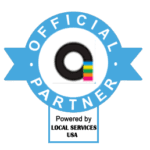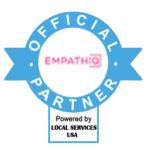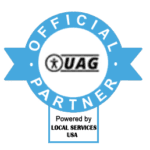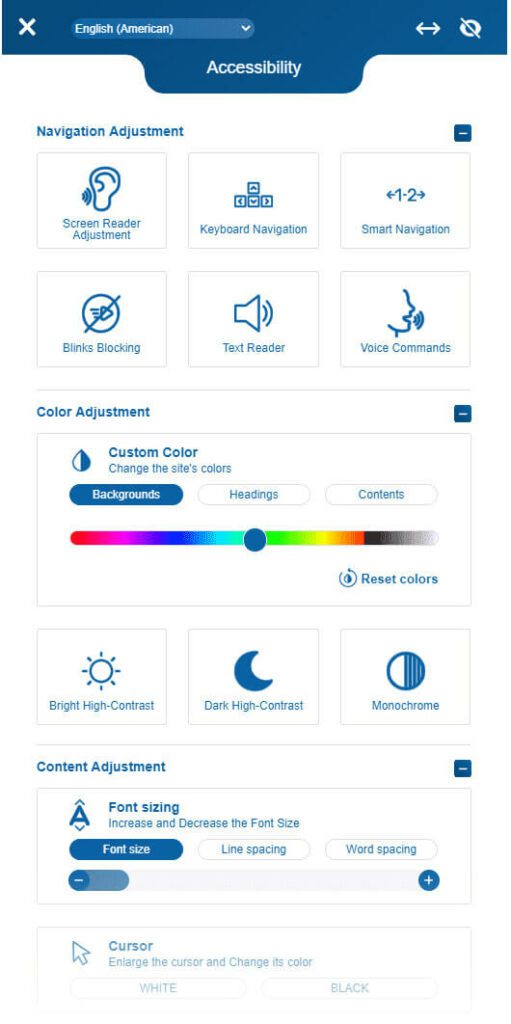Make Your Website ADA-Compliant and Reach 20% More Audience!




















Ensure Accessibility & Increase Leads & Sales - Achieve ADA (WCAG) Compliance Now!
We use innovative technologies to ensure that all websites are fully compliant with the Americans with Disabilities Act (ADA). Our solutions are easy to implement and cost-effective, guaranteeing an optimal experience for everyone no matter their physical limitations.


Nearly 20% of the US Internet users are disabled
Our goal is to empower those with disabilities to better access today's digital world. We are committed to creating accessible digital products for all users with our specialized techniques for the visually impaired, the hearing impaired, and those who suffer from mobility issues.
Our experienced staff is not only highly trained in captioning and transcription, but they also specialize in creating custom-made captions, transcripts, and subtitles to fit any of your needs.
By making your website ADA-compliant, you can attract more customers, improve customer satisfaction rates, and stand out from competitors who don't implement accessibility standards. At Business Inc Online, we provide tailored services that make sure your website's digital content reaches all users, across a range of devices and disabilities.




Business Inc Online Offers $1M Compliance Warranty
Our comprehensive approach to website accessibility involves several tiers of service from simple one-line widgets to full on-site inspections. With our experience and expertise, we guarantee the highest quality of services and are so confident about our work that if you get sued for not being accessible, we offer a massive $1 million warranty.
Text Reader Feature
We understand how difficult it can be to read and comprehend long texts – that’s why we offer our readers an easy to use program that will make navigating press releases, emails, documents, and more easier than ever. Join us and start exploring today!




Keyboard Navigation
We specialize in delivering tools that are designed to make accessibilty easier for users. Our team of experts have developed a function that meets the WCAG 2.0 requirements and provides full accessibilty for those with motor disabilities or visual impairments. This function enables users to use their keyboards to navigate through webpages with ease.
Blinks Blocking
Blinks Blocking Tool is an innovative service designed to assist those prone to distraction caused by flickering, strobing, or flashing effects. We understand the challenges that individuals with learning difficulties face and want to help by providing a feature that blocks graphic elements, marquees, news-tickers, galleries, auto-play and other animations which may result in epileptic seizures or cause considerable discomfort.




Monochrome, Bright High Contrast, Dark High Contrast
Contrast Solution is a revolutionary web-based tool that enables its users to adjust the contrast between their background and text in order to ensure maximum readability.
This innovative tool provides three distinct contrast display options, which range from a light grey background with black text color to a stark white background with blue text color.
Image Descriptions
We are committed to helping businesses create content that is accessible to all audiences. We specialize in creating text alternatives for non-textual content such as images, graphics and videos according to the WCAG 2.0 guidelines.
Our image description tool is designed to make it easier for people with disabilities to access content on your website. The tool follows the section 1.4.5 of the Web Content Accessibility Guidelines (WCAG) Success criterion, which is designed to ensure that websites are accessible to people with disabilities by providing clear and accurate descriptions of images.




Accessibility Toolbar & Additional Functions
It provides users the ability to easily increase or decrease text size as well as select an easily-readable, basic font without compromising function and readability. With its unique accessibility features, DecFontSize allows users to customize web content that best suits their needs, making it easier and more efficient to consume information online.
WCAG 2.0 level AAA solution
We specialize in revolutionary accessibility solutions that meet WCAG 2.0 guidelines and the highest conformance level of “Triple-A”. Our suite of packaged tools are easy to install and provides users with an exceptional online experience.


Pricing & FAQ
How quick can you improve review ranking?
We strive to provide our clients with a 3-star ranking — and given enough time, we can achieve a 4-star rating within two months.
What's the optimal ranking average?
We strive to help our clients leave a great impression and boost their leads into sales in the most efficient way. Our services are tailored to meet the unique needs of each business, from small businesses to larger corporations.
Have More Questions? Contact Our Experts Today!
Our team specializes in helping website owners make their sites accessible to people with disabilities, maximizing accessibility and usability for all users. Our custom solution is catered to your needs, providing specialized services such as HTML code reviews, PDF/image accessbility evaluations, color contrast analysis, and more.
Contact one of your experts TODAY!


Our Experts are Ready to Help!
Connect with one of our Local Experts today and discuss your requirements. Free advice.


Want to connect with a marketing expert? Dial in!
123 - 456 - 7890


Get More Engagement With Our Website Accessibility Service
As a business owner, it's essential to ensure that your website is accessible to all users, regardless of their disabilities. In today's digital age, having an accessible website is not only a legal requirement but also a crucial aspect of user experience. By providing an inclusive website experience, you can increase engagement and loyalty from your customers. With our website accessibility service, you can ensure that your website is compliant with the latest accessibility guidelines and regulations.
Our team of experts will work with you to identify and resolve any accessibility issues on your website, including text alternatives, keyboard navigation, and more. By making your website more accessible, you can improve your brand reputation and attract a wider audience.
Our website accessibility service is designed to help you achieve your business goals while ensuring that your website is inclusive and accessible to all. With our service, you can focus on what you do best while leaving the accessibility aspect to us.
What Our Client Says






Some More on Website Accessibility
As digital technology continues to evolve, website accessibility has become a critical issue that businesses and organizations cannot afford to ignore. In recent years, there has been a growing awareness of web accessibility and the importance of ensuring that all users, including those with disabilities, can easily access and navigate websites. The Americans with Disabilities Act (ADA) has set guidelines for website accessibility, and failure to comply with these guidelines can result in legal action.
Why Opt For Our Website Accessibility Service?
In today's digital age, it is crucial for businesses to have a strong online presence, but it is equally important to ensure that their websites are accessible to all users, including those with disabilities. Website accessibility is a legal requirement in many countries, and it is also a moral obligation to ensure that everyone has equal access to information and services online. At our company, we understand the importance of website accessibility, and we offer a comprehensive service to help businesses make their websites more accessible.
Our website accessibility service is designed to address the needs of all users, including those with visual, auditory, and cognitive impairments. We use the latest techniques and technologies to make websites more accessible, including adding alternative text for images, providing closed captions for videos, and improving keyboard navigation. Our team of experts has a deep understanding of the accessibility guidelines and standards, and we work closely with businesses to ensure that their websites comply with legal requirements and best practices.
Ready to Grow? Get your FREE Quote Today!
How is Website Accessibility Managed and Enforced?
In today's digital age, websites are essential for businesses and organizations to reach their target audience. However, it is equally important to make sure that these websites are accessible to all individuals, including those with disabilities. Website accessibility refers to the inclusive design and development of websites, mobile apps, and online documents to ensure that people with disabilities can use them effectively. With the rise of digital transformation, accessibility has become crucial for businesses to provide equal opportunities to everyone.
Despite the legal obligations, many organizations ignore website accessibility, resulting in discrimination against people with disabilities. Therefore, it's essential to understand how website accessibility is managed and enforced. This blog post will explore the strategies and approaches that businesses can implement to ensure website accessibility. It will also discuss the legal frameworks, standards, and regulations that govern website accessibility compliance.
Web Accessibility Enforcement
Web Accessibility Enforcement is a crucial aspect of web design and development. It refers to the process of making websites accessible to people with disabilities, including those with visual, hearing, and mobility impairments.
In recent years, there has been a growing emphasis on ensuring that websites comply with accessibility standards, particularly in the public sector. The legal landscape is also evolving, with various laws and regulations requiring websites to be accessible to all users. To enforce web accessibility, web designers and developers need to incorporate accessibility features into their designs, such as text alternatives for images, keyboard accessibility, and color contrast.
Moreover, organizations need to conduct regular accessibility audits and testing to ensure ongoing compliance. By prioritizing web accessibility enforcement, businesses and organizations can create a more inclusive online environment for all users.
Standards of Website Accessibility
Website accessibility is a crucial aspect of web design that cannot be overlooked. As more and more people rely on websites to access information, products, and services, it is vital to ensure that these websites are accessible to everyone, regardless of their disabilities. Standards of website accessibility have been put in place to guide web designers in making their websites accessible to all. These standards cover a wide range of factors, including the use of alt tags for images, providing captions for videos, and ensuring that websites can be navigated using only a keyboard. By following these standards, web designers can create websites that are accessible to everyone, regardless of their abilities or disabilities.
1.
Website Accessibility Must Be Perceivable
When discussing website accessibility, it's crucial to address the principle of perceivability. This principle ensures that users can perceive and understand the content presented on a website, regardless of their abilities or disabilities. To achieve perceivability, website designers must consider various factors, such as using clear and concise language, providing alternative text for images and videos, and ensuring that color contrast is sufficient.
Websites that prioritize perceivability create a more inclusive and user-friendly experience for all visitors. In turn, this can increase engagement, reduce bounce rates, and enhance a company's reputation for being accessible and welcoming to all.
2.
It Must Be Operable
When it comes to designing and implementing technological systems, it is crucial to consider the operability of the system. Operability refers to the ease with which users can interact with and use the system. A system that is not operable can lead to frustration, inefficiency, and even safety hazards.
It is essential to ensure that the system is designed with the end-user in mind and that the user interface is intuitive and straightforward to use. Additionally, operability should be tested thoroughly during the development process to identify any issues and ensure they are addressed before the system is deployed.
3.
Website Accessibility Must Be Understandable
Every form of content represented on your website must be easy to understand. Whether visual content like graphic design and videos or just written content, your website visitors must be able to understand what it's on your website. Jumbled language is complex for a visitor to interpret and has the propensity to limit access to people with impairment and cognitive limitations. This also includes people who do not speak your website language as their predominant language.
You must apply this principle to your website structure as well. Every page on your website has to be organized intuitively. Did navigation buttons or pathways must be available on all pages to facilitate smooth transitioning.
4.
It Must Be Robust
“It Must Be Robust” refers to the importance of ensuring that a product or service is able to withstand a range of stresses and strains without breaking down. This concept is particularly important in the development of technology and software, where robustness can be the difference between a successful product and a failure. To achieve robustness, designers and engineers must consider a wide range of factors, including the materials used, the environment in which the product will be used, and the potential stresses that it will face.


We have financed over
3 BILLION+
for our clients
Discover how we can help your business.


Let Us Make Your Website Accessible
In today's digital age, websites have become an integral part of our daily lives. They serve as the first point of reference for customers, businesses, and organizations, making it essential to ensure that they are accessible to everyone. Website accessibility refers to the practice of designing and developing a website that can be used by people with disabilities, including the visually impaired, hearing-impaired, and those with motor impairments.
Making your website accessible is not only a moral obligation but also a legal requirement for businesses and organizations. Failure to comply with website accessibility guidelines can result in legal action, negative publicity, and loss of customers.
Therefore, it is crucial to hire a professional web development team that understands the importance of accessibility and can help make your website accessible to everyone.
Guidelines To improve Your Website Accessibility
In today's digital age, it is essential for businesses to ensure that their websites are accessible to everyone, including individuals with disabilities. Website accessibility guidelines encompass various aspects, from design and layout to content and functionality. To improve your website's accessibility, it is vital to follow established web accessibility standards, such as the Web Content Accessibility Guidelines (WCAG) 2.1. This includes implementing clear and concise content, using appropriate color contrast, providing alternative text for images and multimedia, ensuring keyboard navigation, and addressing any potential barriers for users with disabilities.
1.
Guidelines for a Perceivable Website
Guidelines for a perceivable website are crucial for ensuring that all users, regardless of their abilities, can access and understand the content on a website. Perceivability is one of the four principles of web accessibility that requires websites to be designed in a way that enables users to perceive and interact with content.
Alternative to Text (Alt Text)
Alt-text is a powerful and effective way to make your website more accessible to visually impaired visitors. By adding concise descriptions of the images on your website, you are providing a text alternative that conveys the same message as the image. Alt-text ensures that anyone with a visual impairment can still get the message from the image, regardless of whether it’s decorative or carries an important message. Alt-text provides an easy solution for making sure your website is accessible and inclusive to everyone.
Alternative to Time-based Content
As digital content continues to evolve, the traditional time-based approach to content creation is being challenged. An alternative approach is to focus on creating content that is evergreen, meaning that it remains relevant and valuable over time. This approach shifts the focus from producing content quickly and frequently to producing high-quality, timeless content that can be repurposed and shared across multiple platforms.
Adaptable Content Structure
Adaptable content structure refers to the ability of a website or digital platform to flexibly adjust to different devices, screen sizes, and user preferences. In today's digital age, users access content on a variety of devices, from smartphones to tablets and desktops. Therefore, it's crucial to have a content structure that can adapt and respond to these different devices.
Making Your Website Content Easy to Read and See
When it comes to creating a website, it is essential to ensure that the content is easy to read and see. This means taking into consideration the visual appeal of the website, the font size and type, and the use of white space. The website should be visually clean, with a clear hierarchy of information, and use of headings and subheadings to break up text.
2.
Guidelines for an Operable Website
Creating an operable website requires careful attention to detail and adherence to established guidelines. To ensure that your website is user-friendly and accessible to all, it's important to follow certain best practices. First, make sure your website is easy to navigate, with clear headings, menus, and links. Keep your content concise and well-organized, with a consistent layout and design. Make sure your website is optimized for mobile devices, with responsive design and fast loading times.
Allowing Resolute Keyboard Functionality
In today's fast-paced digital world, having a keyboard that performs optimally is essential to ensure productivity and efficiency. Allowing resolute keyboard functionality is a crucial aspect of this, as it allows users to customize their keyboard experience according to their specific needs. By providing users with the flexibility to adjust their keyboard settings, they can enhance their typing speed and accuracy, which ultimately leads to better performance.
Provide Fair Time-limit To Engage With Your Site
Providing a fair time-limit for users to engage with your site can greatly impact their overall experience. By setting a reasonable time-limit, you are ensuring that users have enough time to explore your site and engage with your content without feeling rushed. This, in turn, can lead to increased satisfaction and a higher likelihood of return visits.
Utilized Drop-down Menus
Utilized drop-down menus are an essential tool for web designers and developers to create user-friendly interfaces. They enable users to easily navigate through a website or application by selecting from a list of options, rather than typing or scrolling through pages of content. The proper use of drop-down menus can enhance the overall user experience and increase efficiency.
Do Not Use Blinking Content
When it comes to designing websites, it is crucial to keep in mind the importance of user experience. One of the most significant aspects of user experience is ensuring that content is easily accessible and readable. This is why it is essential to avoid using blinking or flashing content on your website. Blinking content can be distracting and irritating to users, leading to a negative experience.
Provide Ideal Navigation for Users
Providing ideal navigation for users is crucial for any website or application. It ensures that users can easily find what they are looking for and improves their overall experience. Navigation should be intuitive and user-friendly, with clear and concise labels and menus. It's important to consider the user's perspective and design navigation that aligns with their goals and expectations. Additionally, implementing search functionality can further enhance navigation and allow users to quickly find specific content.
3.
Guidelines for an Understandable Website
Guidelines for an understandable website are essential to ensure that users can easily navigate and understand the content on the site. The website's design should be simple, clear, and consistent, with a logical layout that guides users through the site's various sections. The content should be concise, relevant, and presented in a way that is easy to read and understand. Visual elements such as images and videos should be used judiciously and with purpose.
Use Readable Text Content
When it comes to creating content for any medium, readability is key. Using clear, concise language and avoiding jargon or unnecessary complexity can make a huge difference in how your message is received. Not only does readable content make it easier for your audience to understand and engage with your message, it also enhances your credibility as a communicator. Whether you're creating content for a website, social media, or any other platform, it's important to keep your audience's needs and preferences in mind.
Logically Structure Your Web Pages
Logically structuring your web pages is an essential aspect of web design that can greatly impact the user experience. A well-organized website can lead to increased engagement, higher conversion rates, and improved search engine optimization. By structuring your web pages in a logical and intuitive way, you can help users quickly find the information they need and navigate through the site with ease. This can be achieved through the use of clear headings, subheadings, and navigation menus that reflect the hierarchy of the content.
Use Meaningful Error Messages
In order to enhance user experience and facilitate error resolution, it is crucial to the importance of using meaningful error messages. Meaningful error messages should convey clear and concise information about the problem at hand, and provide users with actionable steps to mitigate the issue. Such messages should avoid vague or technical jargon, as it can further confuse users and impede error resolution. It is also important to consider the tone and language used in error messages, as it can heavily influence user perceptions and satisfaction.
4.
Guidelines for a Robust Website
Creating a robust website involves adhering to a set of guidelines that guarantee its success. First and foremost, the website must be visually appealing and easy to navigate. A clear hierarchy of information and a cohesive design will enhance the user experience. The website's content must be engaging, relevant and up-to-date to ensure visitors return.
Finally, implementing security measures such as SSL certificates and regular backups are necessary to protect the website and its users' data.
Writing Parsable HTML Code
Writing parsable HTML code is essential for creating web pages that are easily understood by search engines and assistive technologies. This requires a structured approach to coding that prioritizes semantic and accessible markup. By adhering to best practices such as using appropriate heading tags, alt attributes for images, and avoiding the use of deprecated HTML elements, developers can ensure their code is easy to read and parse. Additionally, using tools like HTML validators and accessibility checkers can help identify and correct any issues in the code.
Tools for Enhancing Website Accessibility
In today's digital age, having a website that is accessible to all users is crucial. In fact, it is not only a legal requirement under the Americans with Disabilities Act (ADA) but also a moral obligation for businesses and organizations to ensure that their website is designed for individuals with disabilities. However, creating an accessible website can be a challenging task for website owners and designers alike. Luckily, there are numerous tools available that can help enhance website accessibility and ensure that all users, regardless of their abilities, can easily access and navigate a website.
WAVE
Wave is a cutting-edge communication platform that enables businesses to engage more effectively with their customers. This innovative tool provides a range of features, including real-time messaging, chatbots, and automated workflows, allowing businesses to streamline their communication processes and enhance customer interactions.
With Wave, businesses can create tailored experiences for their customers by leveraging data-driven insights, segmenting audiences, and personalizing content.
DYNO Mapper
DYNO Mapper is a powerful tool that is designed to help businesses and individuals create effective sitemaps and visualizations of their website. With its intuitive interface and powerful features, DYNO Mapper is an essential tool for anyone looking to optimize their website for search engines and improve their user experience.
Overall, DYNO Mapper is an essential tool for anyone looking to improve their website's performance and user experience.
SortSite
SortSite is a powerful tool that is designed to help organizations create websites that are accessible, usable, and compliant with web standards. It provides a full suite of tools for web developers and designers to test their website's accessibility, usability, and compliance, and it provides detailed reports.
SortSite is an essential tool for any organization that wants to create a website that is accessible and easy to use for all users, including those with disabilities.
Enhance Your Website Accessibility Now
Enhancing website accessibility is not only a legal obligation but also a moral responsibility. It can make a significant difference in the lives of people with disabilities who rely on assistive technologies to access online content.
By following simple guidelines and best practices, website owners can ensure that their content is accessible to everyone, regardless of their abilities. With the growing emphasis on inclusion and diversity, it is crucial to make sure that everyone can access and benefit from the information available on the internet. So, let's take action and make our websites more accessible for all.


